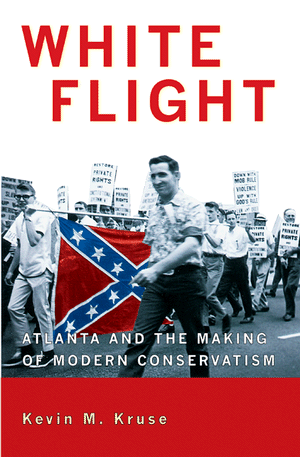Review: White Flight: Atlanta and The Making of Modern Conservatism
By 1970, the north Atlanta suburban counties of Gwinnett, Cobb, and north Fulton had experienced massive explosions in both population and median income. Their racial profiles were also 95, 96, and 99 percent white, respectively (245). In White Flight: Atlanta and the Making of Modern Conservatism, Kevin Kruse explores the processes leading up to this shift. Kruse sets his study within Atlanta’s urban landscape during the 1950s and 1960s and traces the gradual abandonment of spaces by white citizens and its political impact on the development of the conservative movement. By charting three distinct stages of the movement, Kruse reveals a gradual reorientation in political patterns of white resistance, as white Atlantans moved towards a coded ideological emphasis on individual rights, privatization, and small government. Kruse argues that this combination of physical relocation and political consolidation proved to be the most successful strategy employed by those resisting the civil rights movement.
By the late 1940s and early 1950s, working-class whites felt themselves under siege from what they saw as a black invasion of their neighborhoods and public spaces such as parks and swimming pools. Working-class whites at first turned to organized violence and intimidation, but soon realized the importance of winning the battle for public image. In Kruse’s words, “In time, they would learn to put aside the brown shirts of the [white supremacist] Columbians and the white sheets of the Klan and instead present themselves as simple homeowners and concerned citizens.” (44) On an ideological level, they moved from trying to protect the integrity of their communities (a cohesion that Kruse convincingly undermines), and instead began to emphasize their individual rights and liberties to live amongst whomever they chose. In many neighborhoods, their struggle was not enough, as the first wave of black homeowners caused a stampede of white individuals rushing to sell their homes before property values decreased.
Meanwhile, a similar battle over the desegregation of public schools led middle-class whites into the fray during the 1950s. Segregationist leaders quickly picked up on a central theme that ran through their movement (and one that runs through White Flight as well): “freedom of association.” For a middle-class white father, barring blacks from attending the same school as his daughter was purportedly less about denying black people rights as it was preserving his own right to determine who his daughter could and should interact with. Even as this line of reasoning proved ineffectual at halting desegregation, white families fled from public schools into private ones, creating a second-wave of de facto segregation in Atlanta’s school system.
The third stage of white flight came in the early 1960s. As working and middle-class whites faced the integration of their neighborhoods, parks, and schools, many upper-class whites observed the conflict form a distance, safely ensconced in their wealthy neighborhoods, country clubs, and private schools. But with the passage of the Civil Rights Act, suddenly their businesses came under direct assault. Elite businessman, hitherto allied in a moderate coalition with white politicians and black leaders, bitterly struggled against organized sit-in protests and later government injunctions that aimed to desegregate their restaurants and department stores. It was during their struggle that the earlier shifts towards individual rights and privatization crystallized into an organized and increasingly powerful conservative ideology.
The strength of Kruse’s argument lies in tracing this conservative political crystallization, sometimes at the expense of a more rigorous analysis of white flight as a spatial phenomenon. While maps are scattered throughout White Flight, most of them serve as modest visual signposts, when they have the potential to more deeply enrich the project. Nevertheless, Kruse persuasively argues that this tandem of political and spatial movements had profound historical implications. As white Americans increasingly coalesced into white suburban (and later exurban) enclaves, they eventually became the backbone of the Republican party. This “politics of suburban secession,” maintained the traditional tenets of white flight: retreating from any and all interaction with the black community (now synonymous the city itself) and championing minimal government, headlong privatization, and the primacy of the individual.
Kruse is an adept narrator, weaving together a host of characters and events into a compelling storyline of the racial landscape of Atlanta during the mid-20th century. He paints a convincing portrait of a coalescing conservative movement based on withdrawal and charts the distinctive class divisions within this movement. The reader is sometimes left wishing for the kind of broader analysis that mainly occupies the final chapter and epilogue of his book. Atlanta’s patterns of white flight were simultaneously taking place in spaces across the country, yet Kruse offers only passing glimpses of how the city fit within a national framework. Despite this, White Flight remains a compelling case study on the origins of the modern conservative movement within the social and political backlash against the civil rights movement.
Kevin M. Kruse, White Flight: Atlanta and the Making of Modern Conservatism (Princeton University Press, 2005).
